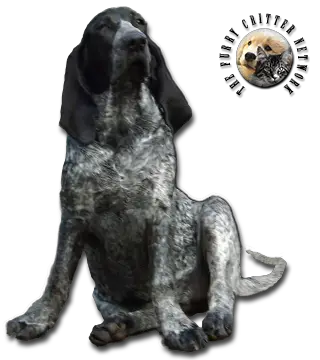Breed Standard
Head: Fairly large and long. Slightly domed skull, not too broad. Slight stop. Pronounced occipital peak. Nosebridge straight or slightly curved. Cheeks cleanly cut, lips fairly pendulous. Wide nose.
Ears: Thin and supple, curled, slightly pointed at the tip.
Eyes: Oval. Brown or dark brown.
Body: Powerful. Neck fairly broad and slightly arched. Pronounced dewlap in the Great Blue Gascony Hound. Well-developed chest. Curved ribs. Muscular loin.
Tail: Well set-on and fairly covered with hair, carried in saber fashion.
Hair: Short, fairly thick, and very dense. In the Griffon, hard, harsh, and dense. Slightly shorter on the head, with fairly thick eyebrows.
Coat: Completely spotted (black and white), creating a slate-blue cast. May be marked with black spots of varying size. Two black spots generally located on either side of the head, covering the ears and eyes and ending at the cheeks. These spots do not meet at the top of the skull but are separated by a white space, often with a small, black, oval spot in the center, characteristic of the breed. Two tan spots of varying richness above the eyebrows, forming pips. Tan markings on the cheeks, flews, inside surface of the ears, the legs, and underside of the tail.
Size: Great Blue Gascony Hound: dog: 65 to 72 cm; bitch: 62 to 68 cm. Small Blue Gascony Hound: dog: 52 to 60 cm; bitch: 50 to 56 cm. Blue Gascony Basset: 34 to 38 cm.
Weight: Great Blue Gascony Hound: approx. 35 kg. Small Blue Gascony Hound: approx. 25 kg.
History
The Blue Gascony Hound, a very ancient breed, is thought to be derived from the Saint Hubert Hound imported from the Ardennes to Gascony in the fourteenth century by Gaston Phoebus, Count of Foix, and crossed with scenthounds. Henri IV had a pack of these dogs for hunting wolf and wild boar. The Blue Gascony Hound exists in several varieties or sub-breeds:
- The Great Blue Gascony Hound, produced from the common strain of Blue Gascony Hounds. This breed is becoming more and more common;
- The Small Blue Gascony Hound, the result crossing a medium-sized Blue Gascony Hound with a coarse-haired griffon (the Vendee Griffon). The standard for this variety was established in 1919. After nearly disappearing, this variety is currently gaining popularity; and
- The Blue Gascony Basset, a variety whose origin is hotly debated. Some believe this breed is the result of a mutation in the Great Blue Gascony Hound. Others say it was produced by crossing the Saintongeois Basset with the Blue Gascony Hound. Later, Great Vend e Bassets and even Artesian Norman Bassets were commonly used. Once quite rare, the Blue Gascony Basset has been gaining popularity over the past twenty years.
Behavior
Whatever the variety, the Blue Gascony Hound is a gifted hunter with a keen sense of smell and a beautiful voice. Enthusiastic and hardy, he works well in packs. - The Great Blue Gascony Hound has a very keen sense of smell and a resonant, deep voice. He is massive and slow but maintains a steady pace on the trail and is very determined. He hunts instinctively in packs but also individually as a bloodhound. He works on large game (deer and wild boar) and also on hare. He is used in the crossbreeding of large game hounds.
- The Small Blue Gascony Hound, lively and active, can hunt most game and is used especially in shooting. Hare is his favorite quarry.
- The Blue Gascony Griffon combines the superb nose and voice of the Blue Gascony Hound with the tenacity of the Griffon. This very versatile breed is excellent on wild boar and is also used on hare. He hunts well in packs and is highly prized for his work on difficult terrain.
- The Blue Gascony Basset, like the Basset Hound, is active, nimble, and gifted with that booming Basset howl. He works like a charm in packs and is used on rabbit and hare. These dogs are gentle, affectionate, and very attached to their owner. They require firm training.
They are not suited to city life. They must live in the country, in a kennel if they are part of a pack. They need exercise and space, as well as regular brushing and attention to the ears.
Function
Hunting Dog
Health
No health information is available.






